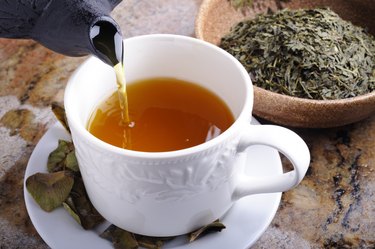
Is it time for you to "go green?" Because green tea is less processed than black tea, it contains more of the beneficial compounds known as flavonoids. These antioxidants offer a range of health benefits. Are some brands, such as the Twinings green tea line of products, better than others?
From Flavor to Flavonoids
Video of the Day
Unless it's blended with herbs or dried fruits, green tea ingredients are limited to the tea leaves themselves. Like black tea, green tea leaves come from the hardy small shrub Camellia sinensis, which is native to Asian regions.
Video of the Day
As Harvard Health Publishing notes, the difference between black and green tea lies in their processing. Black tea leaves are allowed to turn brown, a process known as oxidation, before they are dried. Green tea leaves are dried sooner, before oxidation sets in.
Of course, color and taste also differ between the two types. Black tea is darker, and somewhat richer-tasting, while green tea is lighter, in both color and taste. From a health perspective, stopping oxidation in green tea leaves also halts the breakdown of flavonoid content. Flavonoid is an umbrella term for a group of compounds found in various plants, which have antioxidant benefits.
While flavonoids are considered beneficial to health, too much green tea can have unintended consequences. In general, green tea side effects are minimal if you consume a moderate amount. More than 2 cups a day of Twinings green tea, or other brands, could result in too much caffeine, according to Harvard Health Publishing.
Read more: The Health Benefits of Green Tea With Lemon
Exploring Green Tea Benefits
While both black and green teas have been found to be beneficial for certain aspects of health, green tea's higher flavonoid content gives it the edge in most categories, notes the Linus Pauling Institute (LPI). Among the potential green tea benefits are:
- Lowering blood pressure: According to LPI, several studies bear out the theory that drinking green tea can lower blood pressure. This is true of both systolic blood pressure and diastolic blood pressure rates. Keeping your blood pressure at a healthy rate reduces your risk of stroke or heart attack.
- Decreased cholesterol: Various studies reviewed by LPI showed that in some situations, green tea more reliably lowered LDL cholesterol and triglycerides than black tea. Mayo Clinic additionally puts drinkable green tea, or green tea extracts, in the category of supplements that "may" lower cholesterol, providing an important defense against heart disease.
- Potential cancer protection: As the Memorial Sloan Kettering Cancer Center notes, research is still preliminary about exactly how much protection drinking green tea can provide against cancer. Laboratory animal testing suggests that it may prohibit tumor growth, specifically within the stomach and colon. Green tea shouldn't replace other healthy lifestyle choices shown to reduce the risks of cancer.
Warning
Some green tea side effects, and negative drug interactions, have been reported, according to Memorial Sloan Kettering. Unless you choose decaffeinated types, digestive issues and agitation have been reported as green tea side effects. Green tea can also interfere with a number of drugs, by either increasing their toxicity to the liver, or by making them less effective.
Drinking Twinings Green Tea
If you prefer the Twinings brand of teas, the company's green tea offerings include those with just tea leaves, and also those in which the green tea ingredients include other botanicals. Popular Twinings green tea products include "gunpowder" green tea (loose tea rolled into pellets), "pure" green tea (an organic type), mint green tea and jasmine green tea.
A January 2013 study published in International Journal of Economic Practices and Theories focused on Twinings green and black tea offerings exclusively, and analyzed factors such as caffeine content, phenolic substances and ash content.
The level of phenolic substances in various tea blends influence not only their aromas and colors, but also their levels of flavonoids. The ash content refers to the inorganic matter that is left over after processing. In terms of health and quality, a higher phenolic percentage, and a lower percentage of ash, make for a superior tea.
Read more: White Tea vs. Green Tea
The study found that all of the Twinings green tea products studied were above average in quality, which was attributed to both processing and packaging practices. The pure green tea had the highest phenolic content of all the Twinings green tea products studied, while mint green tea had the lowest.
The pure and mint green tea products proved the lowest in caffeine, while gunpowder and jasmine were the highest. Jasmine green tea had the lowest ash content, and pure green tea had the highest.
- Harvard Health Publishing: Benefit of Drinking Green Tea: The Proof Is In -- Drinking Tea Is Healthy
- Harvard Health Publishing: "Flavonoids - The Secret to Health Benefits of Drinking Black and Green Tea?"
- Linus Pauling Institute: "Tea"
- Mayo Clinic: "Cholesterol-Lowering Supplements May Be Helpful"
- Memorial Sloan Kettering Cancer Center: "Green Tea"
- Twinings: "Green Teas"
- Semantic Scholar: "Study of The Quality of Twinings Tea"